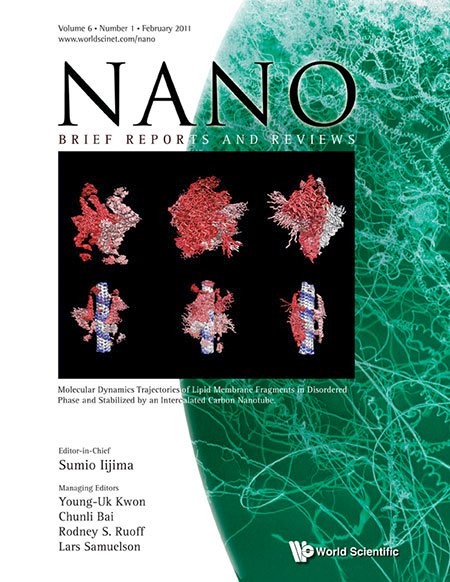System Upgrade on Tue, May 28th, 2024 at 2am (EDT)
Existing users will be able to log into the site and access content. However, E-commerce and registration of new users may not be available for up to 12 hours.For online purchase, please visit us again. Contact us at customercare@wspc.com for any enquiries.
Volume 06, Issue 01 (February 2011)
MAGNETIC NANOCHAINS: A REVIEW
- HUI WANG,
- YIFEI YU,
- YUBIN SUN, and
- QIANWANG CHEN
- Pages:1–17
https://doi.org/10.1142/S1793292011002305

One-dimensional chain-like structures are of special significance because of their interparticle magnetic interactions and potential applications in various fields, such as micromechanical sensors. This paper attempts to review the field of research into magnetic chains including monatomic chains and nanoparticle chains.
MOLECULAR DYNAMICS SIMULATION OF POPC AND POPE LIPID MEMBRANE BILAYERS ENFORCED BY AN INTERCALATED SINGLE-WALL CARBON NANOTUBE
- Pages:19–29
https://doi.org/10.1142/S1793292011002317

The evidence for stabilization of palmitoyloleoylphosphatidylcholine and palmitoyloleoylphosphatidylethanolamine membrane bilayers enforced by a single-wall carbon nanotube is provided via high temperature all-atom molecular dynamics simulation. Based on the root mean square deviation and root mean square fluctuation analyses of simulated structures from their initial states, we show that an intercalated single-wall carbon nanotube restrains the conformational freedom of adjacent lipids and hence has an impact on the membrane stabilization dynamics. This new lipid membrane–nanotube model system has many potential applications and can serve as a generic platform for bringing mobile lipid-bound molecules and nanotubes in close proximity for studies of both electrical and mechanical perturbations at cell membranes.
INCREASING OF THE SHARPNESS OF p–n JUNCTIONS BY LASER PULSES
- Pages:31–40
https://doi.org/10.1142/S1793292011002329

It has been recently shown that inhomogeneity of a semiconductor heterostructure leads to increasing of sharpness of diffusion-junction and implanted-junction rectifiers, which were formed in the multilayer structure. It has been also shown that together with increasing of the sharpness homogeneity of impurity distribution in doped area increases. Both the effect could be increased by the formation of an inhomogeneous distribution of temperature (for example, by laser annealing). Some conditions on correlation between inhomogeneities of the heterostructure ant temperature distribution have been considered. Annealing time has been optimized for laser pulse annealing.
SILICON CARBIDE NANOWIRES FROM POLYVINYL ALCOHOL/SILICA ELECTROSPUN NANOFIBERS
- Pages:41–45
https://doi.org/10.1142/S1793292011002330

The catalyst-free synthesis of silicon carbide (SiC) nanowires was carried out from polyvinyl alcohol (PVA)/silica electrospun nanofibers at high temperature. The TEM results showed that the produced nanowires were crystalline β-SiC and rather homogeneous in thickness with an average diameter around 50 to 70nm and a length of more than 10μm. This provides a methodology to lower the production cost.
PRESENTATION OF BIOACTIVE EPITOPES WITH FREE N-TERMINI ON SELF-ASSEMBLING PEPTIDE NANOFIBERS
- Pages:47–57
https://doi.org/10.1142/S1793292011002391

The branched self-assembling peptides bearing epitopes with free N-termini were designed. Fluorescence enhancement experiments indicated that the charges of the epitope sequences at the lysine branching may have significant impact on conformational freedom and accessibility of the epitopes. Cell entrapment experiments reveal that the attached epitopes with free N-termini are biological active.
POLY(ETHYLENE CO-VINYL ACETATE)-ASSISTED ONE-STEP TRANSFER OF ULTRA-LARGE GRAPHENE
- Pages:59–65
https://doi.org/10.1142/S1793292011002342

40-inch scale of graphene on copper was transferred by roll-to-roll method with poly(thylene co-vinyl acetate) (EVA).Thermoplastic EVA has wide rubbery plateau region. So it can act as a binding material for graphene. After copper etching, 1.96 ± 0.2 kΩ/sq of sheet resistance was realized.
PREPARATION OF NiO NANOPARTICLES ON THE SILICA SURFACE BY ADSORPTION PHASE SYNTHESIS AND ITS REGULATION ON MORPHOLOGY OF NiO PARTICLES
- TING WANG,
- XIN JIANG,
- LI-GUANG WU, and
- FEI LIU
- Pages:67–74
https://doi.org/10.1142/S1793292011002354

NiO particles with less than 5 nm of size have been prepared by adsorption phase synthesis. The morphology of NiO particles could be regulated by the change of many conditions, including reactant quantity, temperature and water concentration in preparation. When the quantity of reactants was lower than 2.0 mmol, there was no significant change in grain size of NiO. The grain size of NiO particles first decreased and then increased slightly with temperature increasing.
SYNTHESIS AND PHOTOLUMINESCENCE OF WATER-SOLUBLE ZnS:Mn2+/ZnS QUANTUM DOTS BY NUCLEATION DOPING STRATEGY
- ZHANGSEN YU and
- XIYING MA
- Pages:75–79
https://doi.org/10.1142/S1793292011002366

In the photoluminescence spectrum of the ZnS:Mn2+/ZnS QDs solution, strong yellow luminescence with an emission at 575nm is clearly observed, when excitation wavelength was set at 330 nm. The yellow photoluminescence originates from a transition between the 4T1 excited state and the 6A1 ground state of the Mn2+ ion within a nanocrystalline ZnS lattice.
MnO2-FILLED MULTIWALLED CARBON NANOTUBE/POLYANILINE NANOCOMPOSITES: EFFECT OF LOADING ON THE CONDUCTION PROPERTIES AND ITS PERCOLATION THRESHOLD
- Pages:81–91
https://doi.org/10.1142/S1793292011002378

Nanocomposite of polyaniline/multiwalled carbon nanotube/manganese dioxide has shown a conductivity percolation threshold at 0.5 wt.% with improved interaction and properties at high loading. Scanning electron micrograph exhibits a homogenously dispersed 3D network of tubes. This new ternary nanomaterial has promise for functional applications which require low carbon nanotube content.
ANNEALING BEHAVIORS OF TiO2-SHEATHED SnO2 NANORODS
- Pages:93–99
https://doi.org/10.1142/S179329201100238X

Photoluminescence measurements showed that the major yellow emission of the SnO2 nanorods was enhanced in intensity by sheathing them with TiO2 and further enhanced by annealing them. A reducing atmosphere was found to be more efficient in enhancing the yellow emission by annealing an oxidative atmosphere. The origin of the emission enhancement by coating and annealing is also discussed.

